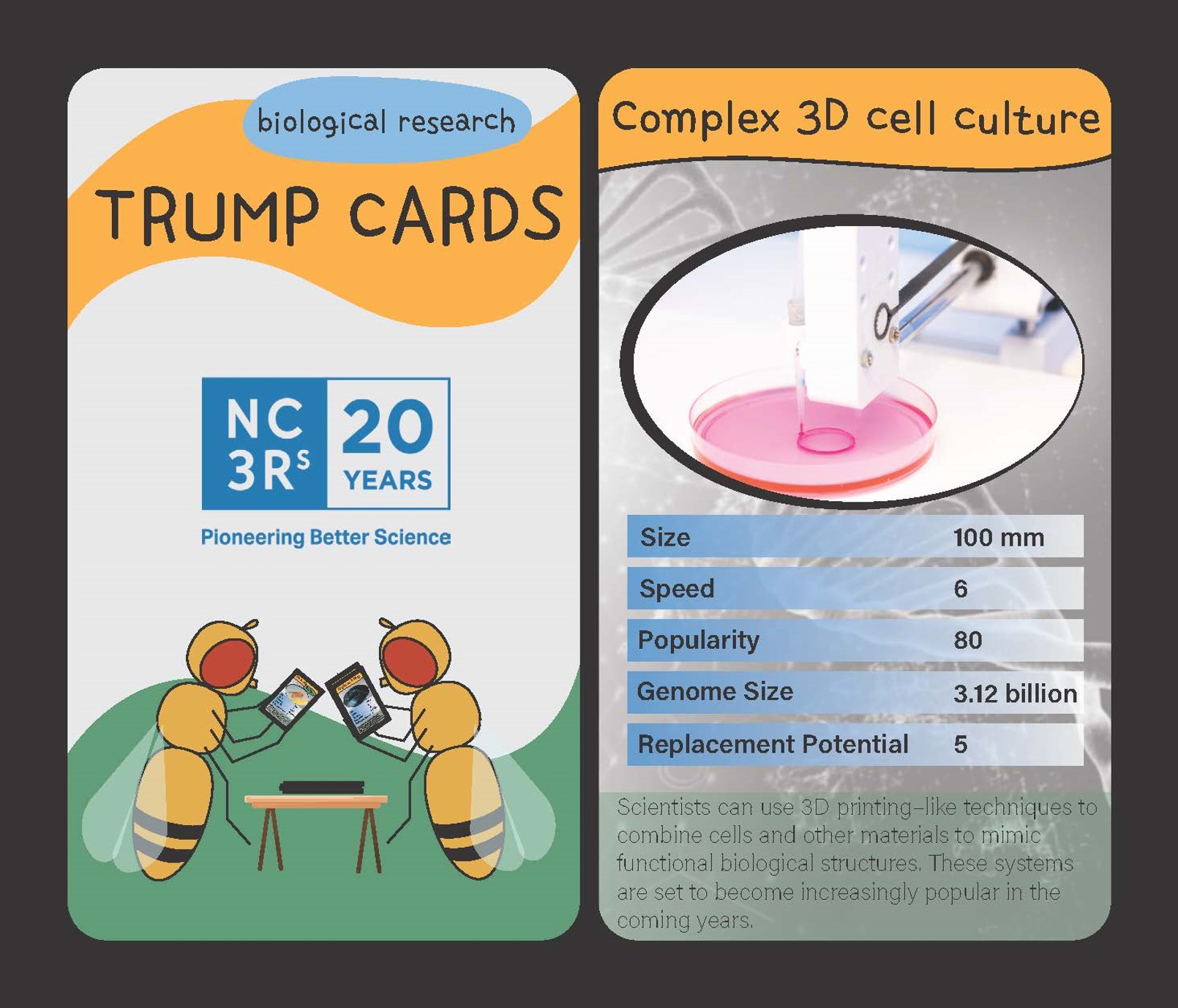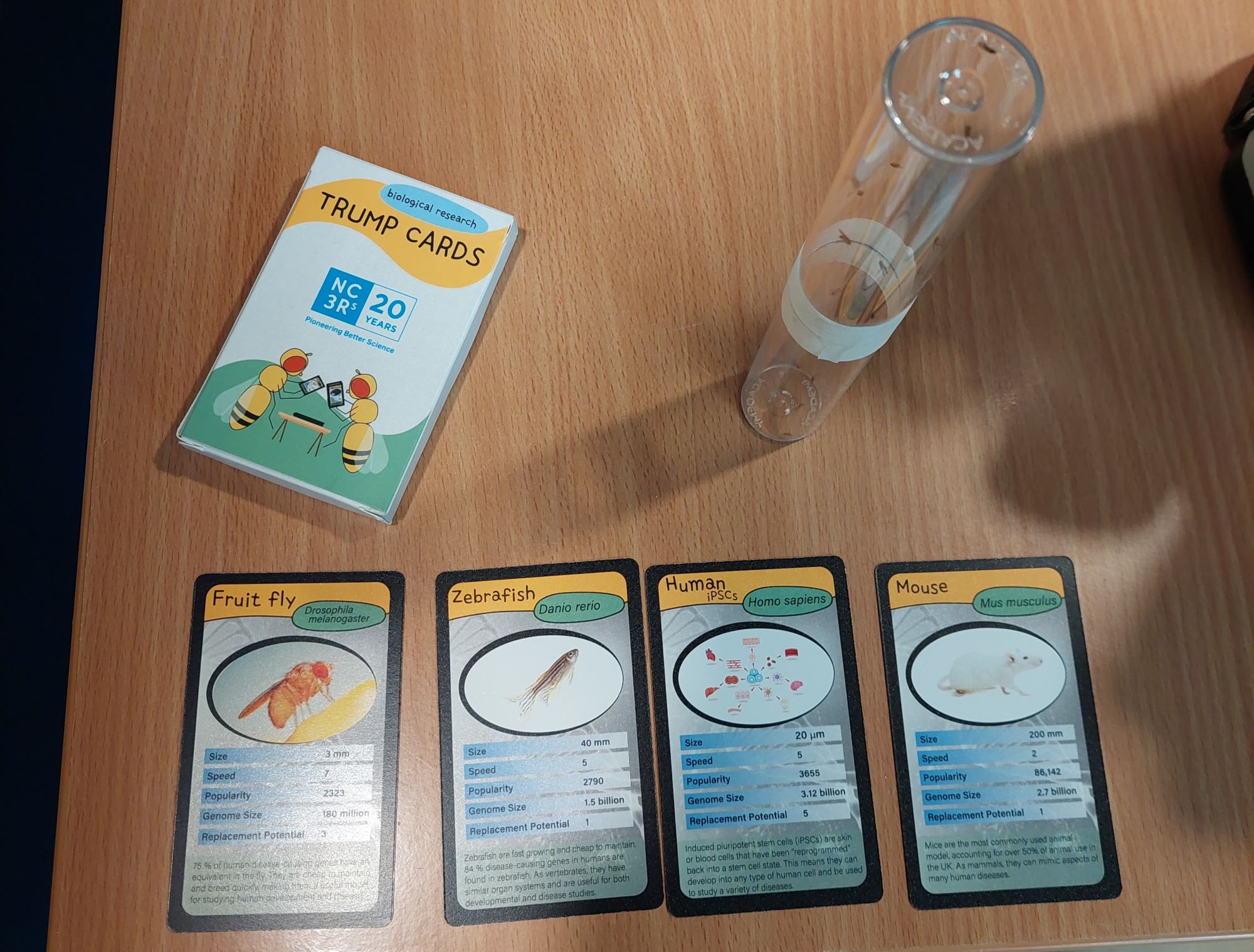Biological Research Trump Cards: from fruit flies to stem cells… who will come out on top?
Posted by Jo Sharpe, on 6 January 2025
In 2023 I was awarded a NC3Rs 20th Anniversary Public Engagement Award to develop and print a “Biological Research Trump Cards” game. I have now designed and printed 100 packs of the game, and my aim is to share them with the scientific community and educators. I hope they will prove a fun and engaging public engagement tool in a variety of different settings.

Please get in touch if you are:
-
- A researcher in an academic setting who would like to use the cards in your outreach programme
-
- A teacher at primary or secondary school and would be interested in having some packs / hosting a workshop (see below for an example)
-
- Interested in using them but unsure if they are suitable for your audience
So what are “Trump Cards”?
There are few people who have gone through life without encountering Top Trumps in some form. First published in 1978, there are now hundreds of different varieties, from football teams to dinosaurs. The gameplay is simple, with users comparing numerical data to try and trump and win an opponent’s card. It is this simplicity, along with the easily adaptable format, that makes it ideal as a customisable public engagement tool.
Why this format?
I have always wanted to create a card game on a scientific theme that is both fun and educational, and Trump cards are an obvious choice – no complicated rules, compact, and the numerical categories offer the opportunity to convey a lot of information on a single card. The idea for the specific theme of these cards came to me after attending an NC3Rs early career researcher event, where I learnt about all the different research models and systems scientists were using for their research.
How was the game developed?
After extensive research into different research models, I came up with a full set of Top Trumps, including systems ranging from mathematical models to sea urchins. I decided to focus the game on the 3Rs message, specifically the replacement of animals in research. Each card has 5 categories, including “replacement potential”, which is based on whether the system is an animal, partial replacement, or full replacement. Together with the NC3Rs team, I fine tuned the cards, making sure it conveyed the 3Rs message in a clear and accessible way. The other categories are “genome size”, “speed”, “size”, and “popularity”, with “speed” referring to how quickly experiments can be carried out, and “popularity” based on the number of articles published in 2019. I designed the cards myself using Adobe Illustrator, and spent many evenings deciding the perfect colour scheme, fonts, and drawing cartoons of fruit flies playing cards.
What is in the pack?
Each pack contains a set of Trump cards, along with explanatory cards for each of the categories, what the NC3Rs is and their mission, and a “how to play” card.
Who are the intended audience?
Top trumps are a well-loved game by children and adults alike, and no prior knowledge of scientific research is necessary to engage with the activity. Most adults and secondary school pupils will have some understanding of how we use animals in research and may have opinions about this, but I anticipate that they will not have been introduced to the myriad other model systems that scientists use. The aim is to promote discussion around the use of animals and alternatives. Younger children will enjoy the pictures and facts about unusual animals, and hopefully it will pique their interest in scientific research.
How do you use the cards?
I have 100 packs for distribution to schools and other researchers for use in their public engagement activities and would be delighted to share them with you. Their use is not limited to playing the full game from start to finish- here are some other examples of ways they can be used:
-
- Short format – one card is chosen at random by each player and one turn is played. This would be most appropriate for stands at science fairs, for example, where people are passing through quickly.
- As illustrations – if you are focusing on one or a few different model systems, the cards can be laid out, or images of them displayed on screen, as a quick way to convey a lot of information about that system. In addition to the numerical categories, there is a description on the bottom of the card explaining what the organism or system is used for.
- Workshops in schools – in addition to simply playing the game, they are a useful tool to get students thinking about why scientists might use different model systems. For example, I have designed a workshop where students are given three scenarios and they have to choose what they think the best three models are for each research aim. This gets them thinking and discussing the advantages and disadvantages of different models, with support from scientists leading the workshop.

Example workshop
I have designed a workshop aimed at secondary school and sixth form students, which is available for you to download. It can easily be adapted to suit different abilities. The workshop begins with a short introduction to modelling and why we do it, followed by examples. It also touches on what to consider when choosing a model. The main activity involves the students choosing three models for each research aim. During this activity, I would allocate one volunteer per group if possible to sit with the students whilst they discuss. This is helpful because they may have technical questions about different systems that would influence their choices. Additionally, you can probe their reasoning and get them to think about less obvious choices. For example, they might not know that fruit flies can be used for exercise experiments, or consider that mathematical modelling could be used for looking at the relationship between diet and motor neuron disease.


 (12 votes)
(12 votes)
what a great idea! How does a teacher contact you? Ironic name given this weeks event.
Hi Elizabeth, you can contact Jo by clicking the ‘get in touch’ link just beneath the first image of this post.
Comment se procurer vos cartes. Belle initiative
That sounds great – I organize outreach activities and public engagement in Germany for the German Stem Cell Network and I would love to see and play your Trump cards – and maybe translate them?
Is there any way of downloading a set and cutting it with a scissor into the right size and play?
Great idea!
Stefanie
Hi Stefanie,
Thank you so much for your comment – please can you email me -Joanne.sharpe@sheffield.ac.uk and I’ll send you some details!